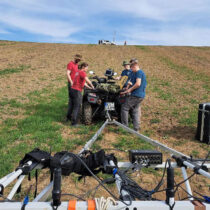The recent work of Greek and Swiss archaeologists has shown that Eretria, the well known coastal Euboean town, had been one of the most important Mediterranean settlements in the Geometric period, especially during the years 800 to 700 BC, with the second half of the eighth century marking its climax. Vaulted and rectangular buildings dating from this phase have been excavated mainly by the harbour, revealing most significant finds: An intact skyphos was discovered in situ containing a quantity of gold in a variety of sizes and shapes. This unique and precious find is the hoard of a goldsmith who was both a caster and jewel maker. The talanda of gold found in this hoard bear no relation either with those of Salamina, Cyprus, or with the Babylonian shekel and the Homeric talanda. The great variety of their size, shape and weight make their identification as trading units most improbable.
The hoard did not however contain only talanda but also misshapen jewelry which would be melted so as to take the shape of the talandon, that is the raw material of a goldsmith’s workshop. Although evidence is scarce at present, it must be seriously considered as probable that a temple of the eighth century BC existed in close proximity to the edifice containing the treasured gold . Nevertheless, the existence of a sacred temenos with a temple in the Roman period as well as of workshops and shops in the third and second centuries BC has been positively ascertained.

